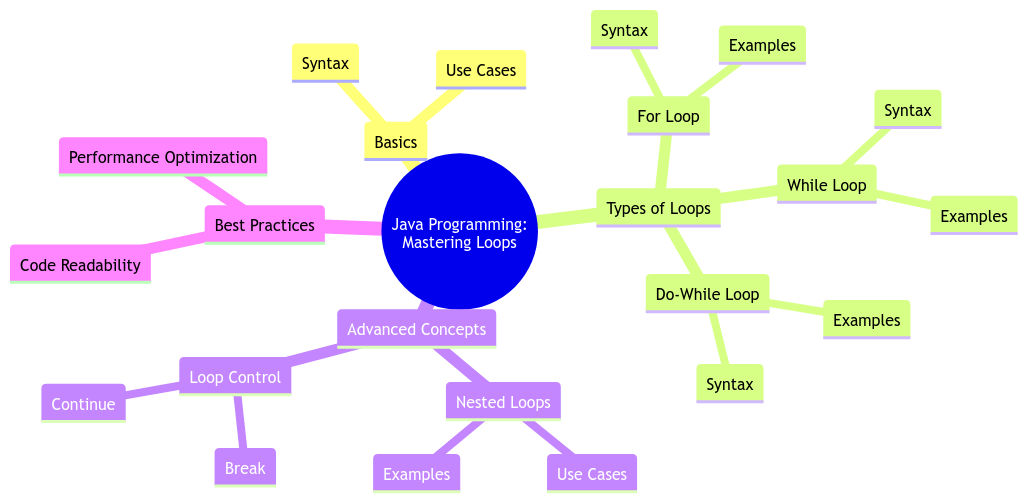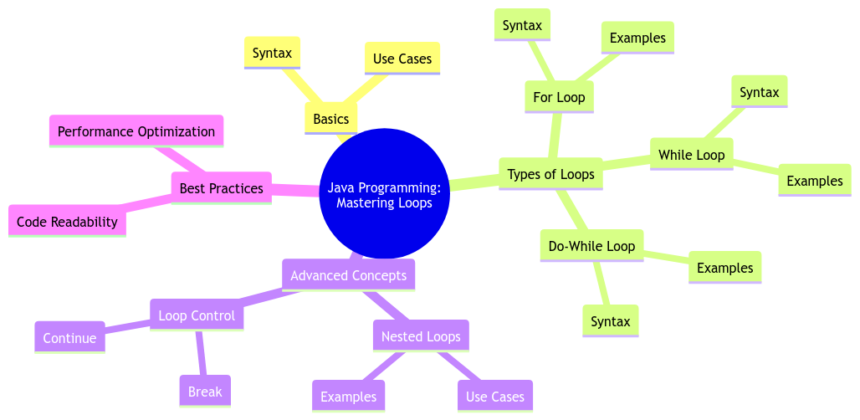Mastering Loops in Java Programming: 🚀
Java, oh Java! The land of curly braces and endless possibilities. Today, we’re diving headfirst into the intricate world of loops in Java programming. 🤓
Understanding Loops in Java Programming
Loops are like that loyal friend who will keep doing the same thing until you tell them to stop. In Java, we have two main types of loops: the trustworthy For Loop and the ever-looping While Loop. Let’s break them down, shall we?
Types of Loops
- For Loop 🔄
Ah, the classic For Loop! Perfect for when you know exactly how many times you want to do something. It’s like having a set number of cookies, and you’re just munching through them one by one. 🍪 - While Loop 🔄
The While Loop is like a curious puppy. It will keep doing something as long as a condition is true. Be careful though, you might end up in an infinite loop if you’re not watching closely! 🐶
Mastering Loops for Effective Coding
Now, let’s level up our loop game! To truly master loops, we need to talk about optimization techniques. Imagine making your loops run faster and smoother. It’s like giving your code a turbo boost! 🏎️
Loop Optimization Techniques
- Loop Unrolling 🌀
Unrolling loops is like spreading out your code, making it run faster by decreasing the overhead caused by loop control. It’s like untangling a knot; suddenly, everything flows seamlessly! 🧶 - Loop Fusion 🎇
Loop fusion is the art of combining multiple loops into one, reducing memory access and improving performance. It’s like a dance; your loops move together in perfect harmony! 💃
Enhancing Code Efficiency with Loops
Efficiency is the name of the game. Let’s talk about how we can supercharge our code using nifty statements like Break and Continue. These statements can be the superheroes of your loops, swooping in to save the day! 💥
Using Break and Continue Statements
- Break Statement ⛔
When you need to make a quick exit from a loop, the Break Statement is your best friend. It’s like a trapdoor that magically teleports you out of the loop’s clutches! 🚪 - Continue Statement 🔄
The Continue Statement is for those moments when you want to skip ahead and keep going without finishing the current iteration. It’s like saying, “I’ll catch up with you later!” 🏃
Best Practices for Looping in Java
Let’s not fall into the dreaded trap of infinite loops! To be a loop ninja, we need to follow some best practices. Avoiding infinite loops is crucial, and we need to update loop control variables correctly and set proper exit conditions. Let’s loop responsibly! 🧐
Avoiding Infinite Loops
- Updating Loop Control Variables Correctly 🔄
Messing up your loop control variables can lead to disaster. Make sure they are updating correctly to avoid getting stuck in a loop forever. It’s like following the right path on a treasure map; wrong turns can lead you astray! 🗺️ - Properly Using Loop Exit Conditions ✋
Setting the right exit conditions is paramount. It’s like knowing when to leave a party; you don’t want to be stuck there forever, right? 🎉
Advanced Looping Concepts
Now, let’s venture into the world of advanced looping concepts. Nested loops are where things start to get really interesting. Get ready to dive deep into multidimensional arrays and optimization techniques! 🤯
Nested Loops
- Using Nested Loops for Multidimensional Arrays 🔄
Multidimensional arrays are like a box of chocolates; you never know what you’re gonna get! Nested loops help us navigate through these complex structures with ease. 🍫 - Nested Loop Optimization Techniques 🎯
Optimizing nested loops is like solving a puzzle. You want to find the most efficient way to traverse through your data, making sure your code runs like a well-oiled machine. 🧩
Closing Thoughts 🌟
Overall, mastering loops in Java is like learning a new dance. At first, it may seem tricky, but with practice and the right moves, you’ll soon be grooving through your code effortlessly. Remember, loops are your allies in the world of programming. Embrace them, optimize them, and watch your code shine! ✨
Thank you for joining me on this loop-tastic journey! Until next time, happy coding! 🚀👩💻

Program Code – Java Programming: Mastering Loops for Effective Coding
public class LoopMaster {
public static void main(String[] args) {
// Example 1: For Loop for counting from 1 to 10
System.out.println('Example 1: For Loop Output');
for(int i = 1; i <= 10; i++) {
System.out.print(i + ' ');
}
System.out.println('
--------------------------------');
// Example 2: While Loop for decrementing from 10 to 1
System.out.println('Example 2: While Loop Output');
int counter = 10;
while(counter > 0) {
System.out.print(counter + ' ');
counter--;
}
System.out.println('
--------------------------------');
// Example 3: Do-While Loop for counting even numbers between 1 and 10
System.out.println('Example 3: Do-While Loop Output');
int count = 1;
do {
if(count % 2 == 0) {
System.out.print(count + ' ');
}
count++;
} while(count <= 10);
System.out.println('
--------------------------------');
// Example 4: Nested For Loop to print a pattern
System.out.println('Example 4: Nested For Loop Output (Pattern)');
for(int i = 1; i <= 5; i++) {
for(int j = 1; j <= i; j++) {
System.out.print('* ');
}
System.out.println();
}
}
}
Code Output:
- Example 1: For Loop Output
1 2 3 4 5 6 7 8 9 10 - Example 2: While Loop Output
10 9 8 7 6 5 4 3 2 1 - Example 3: Do-While Loop Output
2 4 6 8 10 - Example 4: Nested For Loop Output (Pattern)
Code Explanation:
This Java program, titled ‘LoopMaster,’ showcases various loop constructs to demonstrate their effective use in coding.
For Loop in Example 1: Initiates with int i = 1 and loops until i <= 10, incrementing i by 1 after each iteration. This loop prints numbers from 1 to 10 in a single line, demonstrating a basic counting mechanism.
While Loop in Example 2: Initializes counter at 10, and decrements it until the counter is greater than 0. This loop displays a countdown from 10 to 1, exemplifying a reverse counting use-case.
Do-While Loop in Example 3: Starts with count = 1 and checks for even numbers till count <= 10. Unlike the for and while loops, the do-while loop ensures that the body is executed at least once, thus, even if the initial condition fails, we’ll see an output.
Nested For Loop in Example 4: Utilizes two for loops; the outer loop manages the rows, and the inner loop controls the number of ‘*’ symbols printed per row. This results in a right triangle pattern of asterisks. Demonstrating patterns like this is a common use for nested loops.
Each example utilizes comments for clarity, making the code more accessible to others and demonstrating effective documentation practices. Implementing these loops exhibits control over program flow, an essential skill for efficient coding in Java and the mastery of loops for handling repetitive tasks.
Frequently Asked Questions
1. What are the different types of loops available in Java?
In Java, you have three main types of loops: for, while, and do-while loops. Each type of loop has its own use cases and syntax for looping through code efficiently.
2. How do I effectively use a for loop in Java?
To master the for loop in Java, it’s important to understand its three components: initialization, condition, and iteration. By properly managing these components, you can create efficient loops for your code.
3. Can you explain the concept of nested loops in Java?
Nested loops in Java involve having one loop inside another. This can be useful for iterating through multi-dimensional arrays or performing repetitive tasks in a structured manner. However, it’s important to be cautious with nested loops as they can impact the performance of your code.
4. What is the difference between while and do-while loops in Java?
The main difference between while and do-while loops is that the while loop checks the condition before executing the code inside the loop, while the do-while loop executes the code first and then checks the condition. Understanding when to use each type of loop is crucial for efficient coding.
5. How can I avoid common mistakes while using loops in Java?
Common mistakes when working with loops in Java include infinite loops, off-by-one errors, and forgetting to update loop control variables. By carefully planning your loops and testing them effectively, you can avoid these pitfalls and write more effective code.
6. Are there any best practices for optimizing loop performance in Java?
Optimizing loop performance in Java involves considerations such as minimizing the use of nested loops, avoiding unnecessary operations within loops, and properly managing loop termination conditions. Following best practices can help improve the efficiency of your code.







